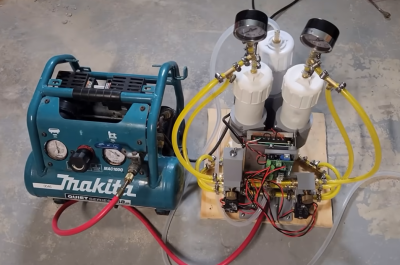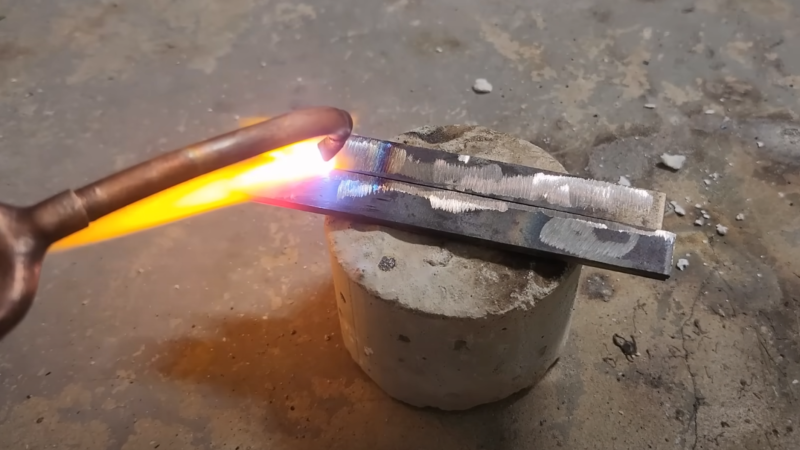By virtue of its triple bond, acetylene burns hotter than any other common hydrocarbon when mixed with oxygen, but it isn’t the only flame hot enough for welding. With the assistance of a homemade oxygen concentrator, [Hyperspace Pirate] was able to make a natural gas torch that melts steel, even if welding with the torch remains difficult.
[Hyperspace Pirate] built his oxygen concentrator around a pressure-swing adsorption system, which uses two tanks of a molecular sieve to selectively adsorb and purge nitrogen, leaving behind mostly oxygen. [Hyperspace Pirate] used reverse-osmosis membrane casings as the tanks, solenoid valves to control gas flow, and an Arduino with some MOSFETs to control the timing. For fuel, he used a convenient source of natural gas, already installed in his garage: the water heater’s gas supply. Since the house’s meter regulates the gas down to a fairly low pressure, and the oxygen concentrator doesn’t produce high pressures, the torch didn’t need any inline regulators.
 Inline check valves, on the other hand, were very much necessary, a mixture of oxygen and natural gas propagating back along the lines being undesirable for obvious reasons, and flashback arrestors would have been a good addition. [Hyperspace Pirate] built the torch itself out of copper tubing and needle valves, with a 0.9 mm MIG welder tip as the nozzle. Adjusting the gas mixture was mostly a matter of trial and error. With an oxygen-rich flame, it could cut thin metal decently well, but it tended to melt thick pieces more than it cut. On the other hand, even with a neutral flame, the water vapor in the exhaust oxidized steel, which made welding quite difficult, but not impossible.
Inline check valves, on the other hand, were very much necessary, a mixture of oxygen and natural gas propagating back along the lines being undesirable for obvious reasons, and flashback arrestors would have been a good addition. [Hyperspace Pirate] built the torch itself out of copper tubing and needle valves, with a 0.9 mm MIG welder tip as the nozzle. Adjusting the gas mixture was mostly a matter of trial and error. With an oxygen-rich flame, it could cut thin metal decently well, but it tended to melt thick pieces more than it cut. On the other hand, even with a neutral flame, the water vapor in the exhaust oxidized steel, which made welding quite difficult, but not impossible.
The oxygen supply by itself was an entertaining tool, turning smoldering pieces of charcoal or steel wool violently incandescent. With the assistance of some steel wool, [Hyperspace Pirate] set a steel tube on fire. With a bit more oxygen, it would probably make an effective thermic lance. If you still want to do your welding with acetylene, he’s also made that before.
















Gonna eat plenty of kebabs to produce enough natural ( ͡° ͜ʖ ͡°) gas for any serious welding project.
lmao
Might require a pressure regulator in that application.
What about brazing? Not meat but steel with brass.
The slightly oxidising flame of natural gas (or LPG) with oxygen should be ideal for brazing, but only a “suck it and see” approach would confirm this.
This dude (hyperspace pirate) constantly brazes copper, I bet he will tell us. Probably an input to his refrigerant shenanigans.
Meat would be braising but you made me chuckle all the same.
Hi we did that at school when I was around 15 or so (64 now) we used natural gas and air from a compressor for brazing screw drivers together that we made in metal work class
Home service natural gas has all kinds of additives that might mess up a weld.
Hydrogen also burns pretty hot, and it’s easy to make from water, together with the right amount of oxygen to burn it. You can even buy commercial units which do this. They are used for flame polishing plastics. I don’t know if these things have enough power to make a big enough flame to weld steel. Saving up and storing the (separated) oxygen and hydrogen seems doable, but it’s not straight forward (research hydrogen brittleness).
watch the video and see that he addresses this point.
So I pressed the play button, and it annoys me in the first second with some (probably unrelated) advertisement. And I did not get beyond that.
Answer: He’s already done a video making an Oxi-Hydrogen torch and he goes over issues with it that make it harder to weld with but easy to cut with.
in the year 2025, you should probably not be browsing the internet without an adblocker.
I have a hydroflux brand jewelers torch, one of the commercial units youre talking about, that I use to do welded repairs on cast metal partial dentures. The melting point of the cobalt chrome alloy is 1315-1440 °C (2399-2624 °F). 316: stainless steel melts at 1,371–1,399 °C (2,500–2,550 °F).
Its torch uses hypodermic needles to deliver a very small and tight but VERY hot flame. A HydroFlux torch’s maximum temperature is 4850°F (2675°C). Im not sure if/how that scales up with a larger torch size, but for the work I do it gets the job done.